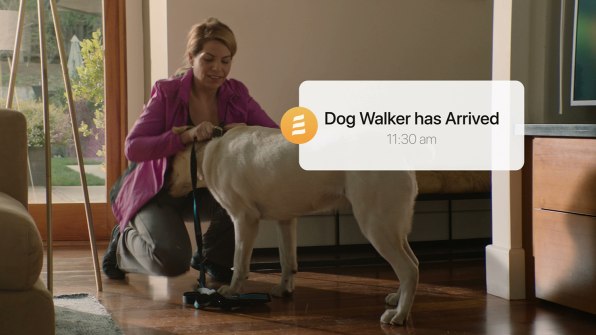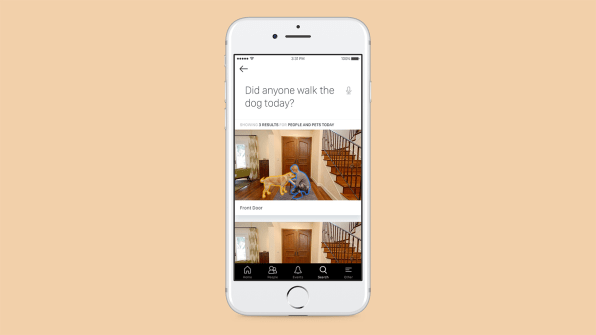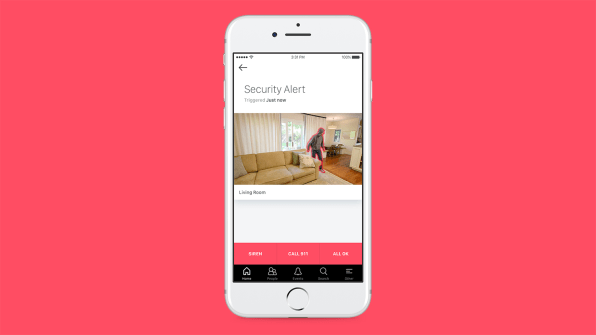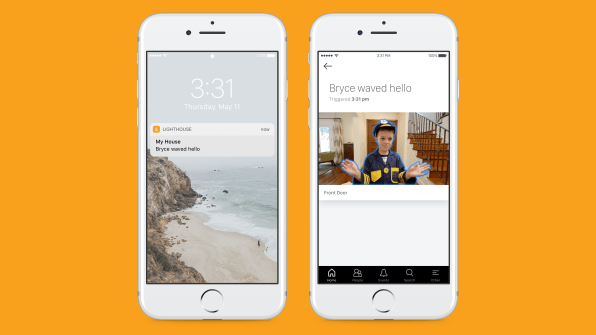For the past three years, I’ve had a Wi-Fi-connected security camera running constantly in my third-floor walkup apartment in San Francisco. Based on how hard it is for me to make it upstairs with a few bags of groceries, I’m not that worried about burglars, but I am concerned about my dog, Tucker. There’s something comforting about being able to confirm that he’s asleep in bed rather than barking uncontrollably.
Now, a new camera launching today out of Playground, the tech incubator founded by Andy Rubin, the father of Android, aims to take my dog monitoring a step further. It adds artificial intelligence to the mix to let you know what’s going on in your home when you’re not there, based on what you’ve told it is important to you. Called Lighthouse, it adds 3D sensing technology and deep learning to a traditional Wi-Fi camera to create a home monitoring solution unlike anything you’ve ever seen before.
Sure, we all want to know if strangers are in our home stealing the TV. But most people use their home security cameras to also do things like check on when the dog walker arrives or when the kids arrive home from school, or, like me, to see if their pooch is barking his face off. With Lighthouse, the camera is able to detect exactly what it’s looking at–for instance, it can tell that it’s your terrier by the door at 2 a.m., not your toddler. It can also understand what’s happening in the image, catalog it, and make it searchable later on.
“We sort of think of it as the inverse of Alexa,” says Jessica Gilmartin, general manager and CMO at Lighthouse, referencing Amazon’s voice assistant. “So, Alexa is a really easy and delightful way for you to understand what’s happening out in the world when you’re home, and Lighthouse is a really easy way for you to understand what’s happening at home when you’re out in the world.”

That search is where Lighthouse, which is about the size of an Amazon Echo, really shines. You can ask it questions like “Who was by the door with the dog this morning?” to determine who might have taken Fido on a walk, or “What time did my kids get home last Tuesday?” Search results are given in video form, so you see the people or animals in question. People are highlighted in blue, and animals in yellow. You can even ask complex questions such as “Were my kids running in the house on Saturday?”

Video results can be saved to your phone or shared with others. Everything you don’t expressly choose to save is archived in the cloud (and encrypted) so you can access it a few weeks down the line if you need to. Cloud storage also means that footage is safe should your home actually get broken into or there’s a fire, and the camera is damaged or destroyed. If you happen to see a break-in or destruction in progress, there are buttons within the app to call 911 or sound an alarm.

For things you expect, you can also set up interesting rules. For instance, if you always expect your kids home between 3-4 p.m. on weekdays, you can have Lighthouse let you know when they don’t arrive home rather than when they do. If you want to talk with your daughter when she gets home, you can set the camera up so if she waves at it when she arrives you’ll receive a push notification and can start chatting with her directly through the camera.

Lighthouse gets its smarts in part from technology used in self-driving cars. CEO and cofounder Alex Teichman led Stanford’s work on self-driving car perception and invented the technology that allows cars to recognize objects that are in front of them, such as people and other cars, and predict what they’ll do next. His cofounder, Hendrik Dahlkamp, was a DARPA Grand Challenge winner for Stanley, the first self-driving car. Dahlkamp was also the first engineer at Google X. All that expertise in computer vision shines in the final product.
“We don’t think of vision as being hard because we just do it, but it’s only right now that this has become possible,” Teichman says. “It’s really because of two things in particular: deep learning, [because] just recently within the first few years we’ve started to have enough computing power to really make use of it, and 3D sensing. And that 3D sensing is something that Hendrik and I took from the self-driving-car world.”

Now, instead of recognizing cars and pedestrians, Teichman and Dahlkamp are using similar technology to distinguish between your 30-pound dog and your 30-pound toddler.
Of course, Lighthouse’s machine-learning system needs plenty of data in order to learn how to recognize imagery on its own. The Lighthouse team has enlisted the help of 150 beta testers that have been using the product for over a year. Their data has helped fine-tune the product for launch. Henceforth, customers will be able to opt into an early-access program that gives them access to new Lighthouse features first in exchange for sharing their data with the company to make the product smarter. If users don’t opt-in, their data won’t be used.
Preorders for Lighthouse start today on the company’s website. The product is sold with a monthly subscription service for video monitoring. The camera is $399 with one year of service, $499 with three years, and $599 with five years. After the initial subscription period, service can be continued for $10 per month.
Fast Company , Read Full Story
(45)